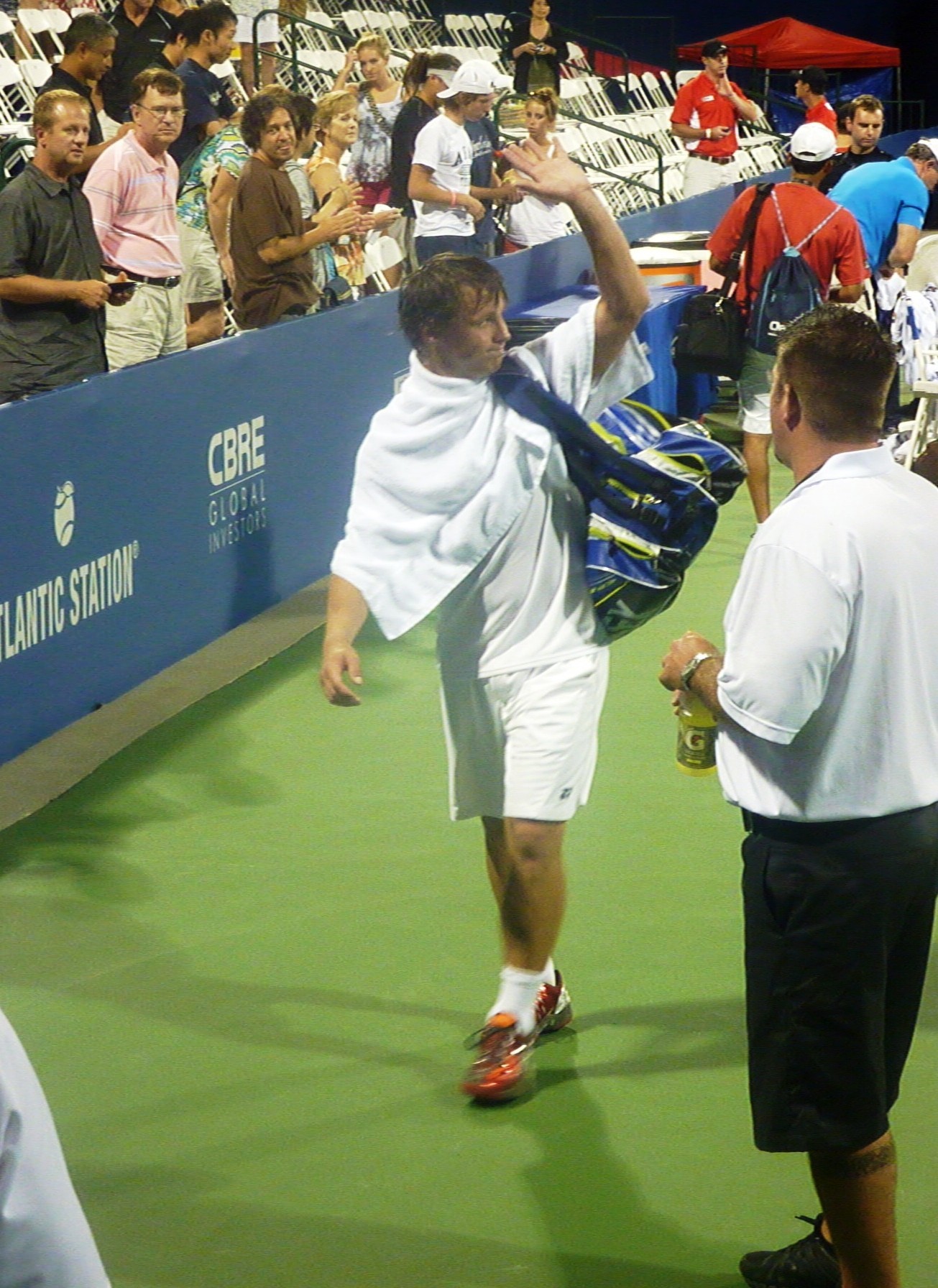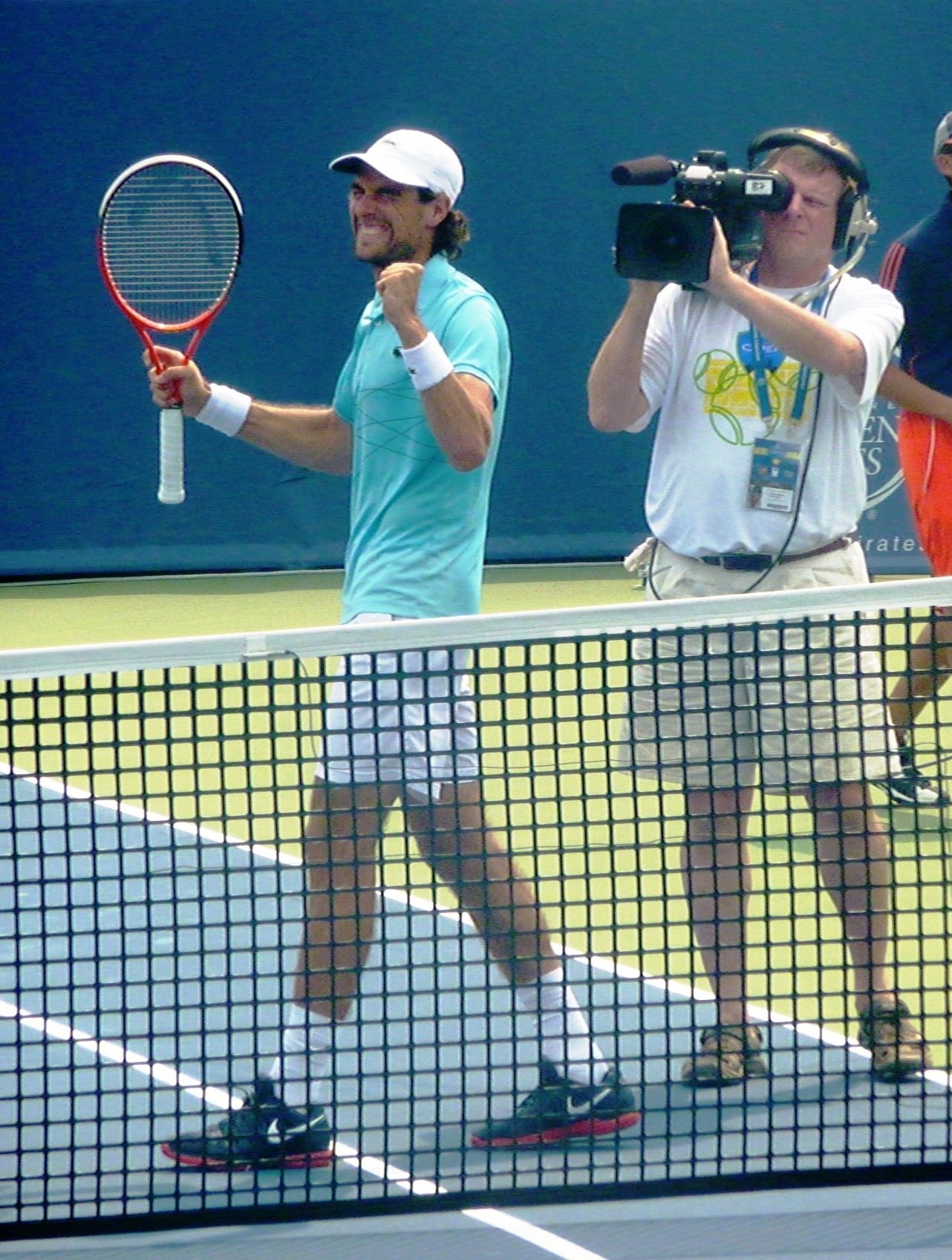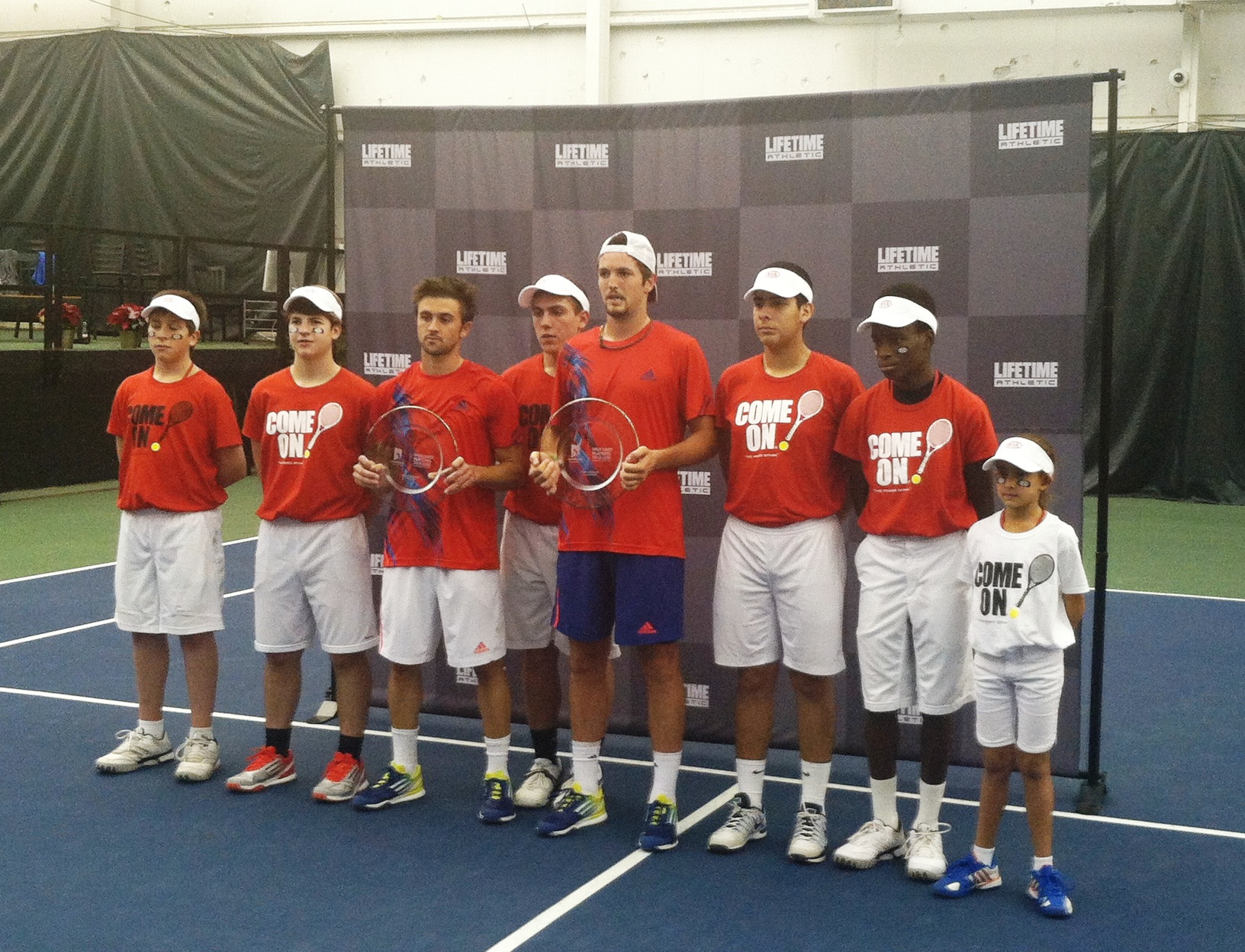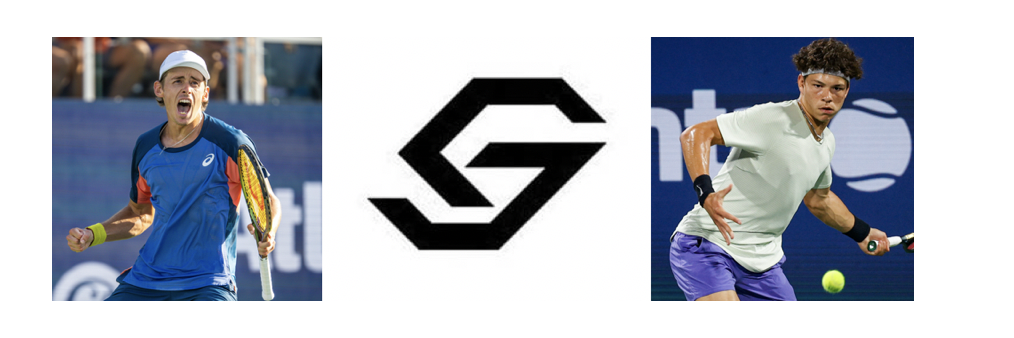What is easily detected by a radar? Bernard Tomic behind the wheel of a car.
So, too, are the biggest stars in men’s tennis. We all know Novak Djokovic bagged a fourth title Down Under, Andy Murray finished runner-up in another major final, and Stanislas Wawrinka battled Djokovic in what could go down as the best match of the year. But who went under the radar and still managed to really catch your attention at the Happy Slam? The Grandstand has another roundtable discussion, this time breaking down some of the standout performers of the 2013 Australian Open who were not so well-documented.
Josh (The Sixth Set): I was impressed with the breakout performances by two of Russia’s rising stars, Andrey Kuznetsov and Evgeny Donskoy. Both enjoyed great 2012 campaigns at the Challenger Tour level, combining for nine titles, and their success translated to their first Grand Slam victories last week at Melbourne Park. Kuznetsov stunned No. 11 seed Juan Monaco in the first round and Donskoy battled past countryman Mikhail Youzhny in five sets en route to the third round. Kuznetsov particularly impressed me with his heavy forehand and great court coverage. Both have cracked the Top 80 with their Aussie Open results and should be fixtures on the ATP Tour in 2013.
Steen (Tennis East Coast): I concur on the displays that both Kuznetsov and Donskoy put up even against somewhat off-form competition, and Russian tennis seems to have a bright future ahead with those two young talents. I will also point to Ricardas Berankis, who probably has the talent to be a Top 20 player but has been derailed by some injuries at a young age. He made the third round with wins over Sergiy Stakhovsky and No. 25 seed Florian Mayer followed by a quality showing against Murray, in fact giving him the best match of any his pre- semifinal opponents. His inexperienced only really showed when he didn’t convert the chances he had in that match. Beyond Berankis, in terms of younger guys Bernie Tomic (for all of his arrogance) still made the third round and showed skill and grit. He might not be the most popular guy around, but you can’t deny he is much improved over last year.

Ricky: Steen stole the words right out of my mouth. Berankis was my go-to guy in this category. I’ve been waiting for him to emerge ever since winning the U.S. Open junior title in 2007 (yes, way back in 2007!). Injuries have cursed him, but he qualified for the main draw, played well against Stako, and completely decimated Mayer. As Steen pointed out, Berankis gave Murray by far his biggest test prior to the semifinal against Federer (granted that isn’t saying much given Murray’s porous draw, but still….). The Lithuanian is only 5’9”, but he hits a bigger ball than–say–David Ferrer and he should take heart from looking at Ferrer’s success and longevity.
I totally agree on Kuznetsov (I’ve been on his bandwagon since his utter domination of the Challenger circuit last fall) and I was also impressed with Daniel Brands. For me, Brands vs. Tomic in the second round was an underrated match.
Brands-Tomic highlights:
[youtube=http://www.youtube.com/watch?v=gWSoZ4f1yMA]
Josh: It looks like we’re all in agreement on Berankis. Like Ricky said, it’s been more than five years since he won the U.S. Open junior title and everyone has been waiting for him to finally make some noise on the tour level. He’s back inside the Top 100, having destroyed Mayer and turning in a solid performance against Murray. To follow up on Steen’s mention of Lacko, the Slovak seems to enjoy playing in Melbourne after also coming from behind to upset Ivan Ljubicic last year, reaching the third round. He’s a tricky opponent who happened to catch Tipsarevic on an off night and nearly pulled off one of the biggest upsets of the tournament.I can’t say it would have been the biggest, however, as that honor goes to Juan Martin Del Potro’s shocking early exit to Jeremy Chardy. Speaking of Chardy, that’s a name we haven’t mentioned yet. The Frenchman reached his first Grand Slam quarterfinal behind a rather surprisingly consistent performance Down Under, upsetting three seeded opponents in a row. He gave Delpo an array of different shots to deal with and the Argentine wasn’t able–and was unwilling–to adjust his heavy-hitting game and break from his comfort zone.
Ricky: Chardy was great in Melbourne, it has to be said, but he didn’t blow me away. I saw things from Kuznetsov (huge hitting without losing consistency, albeit against a hobbled opponent) and Berankis (increased MPHs on serve and backhand, plus better defense–assuming the latter because he was finally 100 percent) that I had not seen before, but Chardy was just more of the same for me. When his forehand is on, it’s one of the biggest weapons on tour. When it’s off, his game falls apart. The Frenchman was completely “on” until the quarterfinals, but I have no reason to think he will sustain such a level with any real consistency in 2013.

On that note, who else impressed you in Melbourne, maybe not in a way that gives you hope for the future (like Kuznetsov and Berankis, for example), but in a way that for some reason or other you won’t forget anytime soon.
Steen: I want to give some props to the older grinder Ivan Dodig, who–instead of being Ivan the Terrible–was Ivan the Tenacious. He snuck his way into the third round, beating Di Wu and Jarkko Nieminen, then took a set off Richard Gasquet. The Croat isn’t a big guy and not the most talented but he does put out a lot of effort. I also have to give respect to both Blaz Kavcic and James Duckworth. Duckworth likely set some sort of AO second-round time record after playing two straight brutal five-setters, and Kavcic prevailed in their epic five-set match in the second round. Before that, Kavcic had beaten the seeded Thomaz Bellucci, a legitimate win for the 25-year-old. Duckworth and Kavcic may not be the most skilled players on tour, but it takes a lot of heart and grit to simply stay out there and play that type of match until the end.
I have to say Gael Monfils always qualifies as someone who makes me take notice. His matches with both Alexandr Dolgopolov and Gilles Simon were timelessly amusing and beautiful train wrecks. Same goes with Fernando Verdasco, who has to get a little bit of credit for sneaking past two Belgians and making the third round, only to fall to Kevin Anderson in five. I’m just not sure where his game is heading at this point and I hope it isn’t much farther down. Then there’s Tim Smyczek, who showed grit as a lucky loser to make the second round and clawed back against Ferrer. He lost but he didn’t give up after being way down, and that has to be appreciated. On the subject of giving up, Nikolay Davydenko continues to disappoint in slams, as he basically admitted he was fatigued after the first four games against Roger Federer after showing signs of a comeback in Doha.As for Chardy, he certainly got plenty of luck to make the quarters. In fact, Del Potro played terribly but almost managed to come back in that match. Otherwise, French Chard basically played three clay-courters (Menendez-Macerias, Granollers, and Seppi) before getting walloped by Murray. Still, anytime a guy makes the quarters of a slam and he is ranked outside the Top 20, it’s a really good showing.
Josh: I like that you brought up Smyczek, because despite being a severely depleted squad I thought the young Americans showed signs of promise at the Aussie Open. Timmy lost the first nine games to Ferrer in the second round but never conceded defeat, remarkably taking a set off the current world No. 4 and battling hard until the final point. He won his first career Grand Slam main-draw match two days prior against big-serving Ivo Karlovic. Two other Americans I enjoyed watching were Steve Johnson and Rhyne Williams. Johnson advanced to the main draw through qualies and Williams earned the USTA’s wild card. Both guys lost in the first round but played a pair of tough five-setters, the former against 10th-seeded Nicolas Almagro and the latter against No. 25 seed Florian Mayer. When their forehands are clicking, Johnson and Williams are machines on hard courts and they exhibited such prowess in Melbourne. I will also say that it was disappointing seeing Jack Sock, who I consider the future of American tennis, bow out in the qualifying round with an ankle injury. Hopefully it wasn’t too serious and he’ll be back for the U.S. hard-court swing next month.
Ricky: How’s this for irony: Smyczek essentially lost THREE times in the same tournament…and it STILL turned out to be the best tournament of his career. He lost in the USTA wildcard playoffs, qualifying, and then to Ferrer. But he made a name for himself by taking out Karlovic then stealing a set off the No. 4 seed–on national television, no less! Johnson and Williams obviously have more potential because of their huge games. Not only did Johnson take Almagro to five, but he also beat Thanasi Kokkinakis 17-15 in the third set in round one of qualifying. Epic effort both in that match and to recover for two more qualifying matches. For now I remain highest on Johnson, but Williams is closing the gap (his match vs. Mayer in which he had two MPs wasn’t on a televised court, but he looked very good in the wildcard playoffs). Williams’ serve isn’t quite as big, but he also has no weaknesses like the Johnson backhand–which is a huge liability. As the results show, neither one is ready for grueling five-setters…but their careers are just starting and their fitness will improve.

Steen, thanks for bringing up Anderson. I almost forgot about him. Holy cow! Did you see him against Verdasco? The mere outcome isn’t shocking because Verdasco is on the way down, but if you saw the match, you know Anderson was completely out of his mind. He was bludgeoning his forehand like never before. It’s a shame he is out for a month with an elbow problem, but hopefully it won’t dent the most positive momentum he’s ever had in his career.
Alright, let’s wrap it up with 1) your favorite under-the-radar match of the Australian Open, and 2) lesser-known player to watch the rest of the year.
Steen: My under-noticed match of AO would be Jarkko Nieminen beating Tommy Haas in five sets for his first career win over the favored Haas. It was an outer-court match that was overshadowed in the early Week-1 blur, but really it was not only long but also of good quality tennis from both guys in the Melbourne heat. It finished 8-6 in the fifth after Haas had taken the fourth set. The flying Finn lost in the next round but it still had to be a good confidence boost for him. As for under-noticed player, I’ll refer back to Daniel Brands, who can be much better than his ranking if he can keep his unforced error count down.
Josh: My favorite under-the-radar match was the second-round meeting between Jerzy Janowicz and Somdev Devvarman–not just because of Janowicz’s epic meltdown in the first set tiebreak, but also due to the fact that he actually won despite falling down two sets to none. The first and fifth sets were competitive and fun to watch, but the middle three featured ugly tennis. The Pole sprayed 88 unforced errors (to Devvarman’s 20), 12 of which were double-faults, and still somehow prevailed.
Janowicz-Devvarman highlights:
[youtube=http://www.youtube.com/watch?v=iUPaKYKisaY]
As for my lesser-known player to watch moving forward, I’m going with Roberto Bautista-Agut, who stunned Tomas Berdych in Chennai en route to his first career ATP final just two weeks before the Aussie Open. Then, in Melbourne, he played consecutive five-setters–including a 6-7, 6-3, 6-7, 6-3, 6-2 second-round loss to No. 26 seed Jurgen Melzer. Coming from a country known for its clay-court genius, it was refreshing to see a Spaniard play well on hard.
Ricky: Yep, I agree on Somdev vs. Jerzy. It was well-known match because of Janowicz’s blowup, but it was actually an entertaining one even without that YouTube immortality. This one had everything that an Aussie Open match should have–five sets in the heat, outrageous momentum swings, and opposing fanbases (one of which was quite inebriated). Somdev may have blown a two-set lead, but that was mainly because Jerzy found his game. The underdog Indian actually stormed back from a 5-2 deficit in the decider (which featured the highest-quality tennis of all five sets) before going down 8-6. Simply by winning one match, Somdev moved up 154 spots in the rankings (I guess that’s what happens when you start a tournament at No. 551!). He is never going to blow anyone off the court, but in this era of slow courts, you can do damage (or you can let opponents do damage to themselves) when you make 20 unforced errors in five sets. That is Somdev’s game, and it will take him back to the Top 70 as long as he stays healthy.
Who did we miss? What did we leave out? Who didn’t get their due credit Down Under? Feel free to join the debate in the comments section!


A thoroughly enjoyable read. Kuznetsov has a lot of talent but he could do with a bit of Guinness and steak diet..